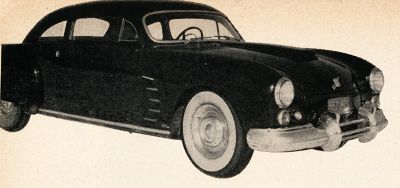Spohn Coachworks











Coachwork company in Ravensburg, Germany run by designer Hermann Spohn. Spohn Coachworks was formed in the early 1920s. In the 1930s Hermann Spohn gained fame with his Bugatti, Mercedes-Benz, Steyr, and Maybach creations. The Maybach people were so impressed with Spohn that as the 1930s dawned they designated the small works as their official Karosseriebauer for their zeppelin-engined goliaths.[7]
In 1931 Hermann Spohn designed a streamlined car that would revolutionize the art of coachwork. Seven months later he had sculptured a body from metal that incorporated such advanced features as a torpedo rear deck, a hidden spare tire, bumper-mounted license plates, recessed door handles, fender-mounted headlights, and fadeway fenders. The car was powered by an aluminum Maybach airplane engine, and was able to drive well over 100 mph.[7]
In 1936 Spohn exhibited another streamlined Maybach creation at the Berlin Automobile Show. Well ahead of its time, this car looked like the grandfather of postwar Studebakers, and boasted such innovations as blended-in fenders. Spohn fit the car with split wipers that were designed to work on the curved windshield. The wipers were the first of the type that the world had ever seen.[7]
During the World War II the French forces occupied Bavaria, and forced Spohn to build French Army vehicles. After the war, the once prominent name was forgotten. In the 1950s American soldiers on occupation duty in Germany rediscovered the talent-full coachbuilder, and had him build them unique custom cars based on american cars. The result was another era of Spohn, and many of the cars he built were based on the design of the 1951 GM LeSabre Concept Car.[8] Josef Eiwanger Jr, current owner of Spohn, and son of one of the original partners, saw a business opportunity with the U.S Army personnel, and had plans about invading the U.S. market with custom bodied Cadillac, Chrysler, and Ford chassis marketed undet the Spohn name.
Contents
The Spohn Plastik
In 1955 Spohn Coachworks created West Germany's first plastic auto body, the Spohn Plastik. The roadster body was mounted on a Volkswagen chassis and had a detachable hard roof section that slided into a recess in the rear. The body was made from polyester resin reinforced with fiberglass mats.[9]
The Gaylord Gladiator
The Gaylord Gladiator is an automobile develooped by the Gaylord Brothers of Chicago. Designed by Brooks Stevens, the Gaylord Brothers wanted to compete with cars such as Rolls-Royce. Two Gladiator prototypes were handcrafted by Spohn. The car made its debut at the 1955 salon de Paris. 25 orders were needed to keep the project afloat. They never came.[10]
Cars Built and Restyled by Spohn Coachworks
Jack T. Chandler's 1941 Ford
Arthur Cooper's 1941 Packard 6
Nickolas M. Staranick's 1947 Buick Sedanette
Charles Justice's 1947 Cadillac
George W. Love's 1947 Oldsmobile
Robert Mooselli's 1948 Mercury
Louis W. Struna's 1949 Lincoln
Ralph W. Angel's 1950 Chevrolet
James L. Price's 1950 Oldsmobile
H. G. Luiscombe Jr.'s 1952 Lincoln
Dan Wylie's 1952 Pontiac Catalina
1952 Spohn Palos
References
- ↑ www.autopuzzles.com
- ↑ www.autopuzzles.com
- ↑ 3.0 3.1 Autopuzzles - Postwar Spohn
- ↑ [pav.-c-49.htm The Dezer Collection]
- ↑ Brandon Thompson
- ↑ Forgotten Fiberglass
- ↑ 7.0 7.1 7.2 Motor Trend November 1953
- ↑ Motor Trend May 1954
- ↑ Car Life June 1955
- ↑ www.chrisinmotion.com
Did you enjoy this article?
Kustomrama is an encyclopedia dedicated to preserve, share and protect traditional hot rod and custom car history from all over the world.
- Help us keep history alive. For as little as 2.99 USD a month you can become a monthly supporter. Click here to learn more.
- Subscribe to our free newsletter and receive regular updates and stories from Kustomrama.
- Do you know someone who would enjoy this article? Click here to forward it.
Can you help us make this article better?
Please get in touch with us at mail@kustomrama.com if you have additional information or photos to share about Spohn Coachworks.
This article was made possible by:
SunTec Auto Glass - Auto Glass Services on Vintage and Classic Cars
Finding a replacement windshield, back or side glass can be a difficult task when restoring your vintage or custom classic car. It doesn't have to be though now with auto glass specialist companies like www.suntecautoglass.com. They can source OEM or OEM-equivalent glass for older makes/models; which will ensure a proper fit every time. Check them out for more details!
Do you want to see your company here? Click here for more info about how you can advertise your business on Kustomrama.















